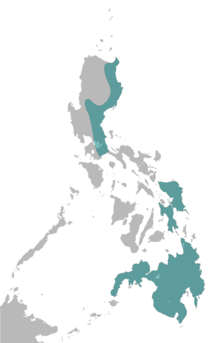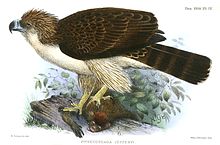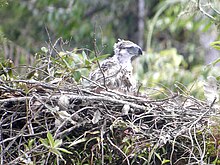Philippine eagle
| Philippine eagle | |
|---|---|

| |
| Philippine eagle at the Philippine Eagle Center, Davao City | |
| Scientific classification | |
| Domain: | Eukaryota |
| Kingdom: | Animalia |
| Phylum: | Chordata |
| Class: | Aves |
| Order: | Accipitriformes |
| Family: | Accipitridae |
| Subfamily: | Circaetinae |
| Genus: | Pithecophaga Ogilvie-Grant, 1896 |
| Species: | P. jefferyi
|
| Binomial name | |
| Pithecophaga jefferyi Ogilvie-Grant, 1896
| |

| |
| Range in blue | |
The Philippine eagle (Pithecophaga jefferyi), also known as the monkey-eating eagle or great Philippine eagle, is a critically endangered species of eagle of the family Accipitridae which is endemic to forests in the Philippines. It has brown and white-colored plumage, a shaggy crest, and generally measures 86 to 102 cm (2.82 to 3.35 ft) in length and weighs 4.04 to 8.0 kg (8.9 to 17.6 lb).
The Philippine eagle is considered the largest of the extant eagles in the world in terms of length and wing surface area, with only
Killing a Philippine eagle is a criminal offence, punishable by law with up to 12 years imprisonment and heavy fines.[7]
Names
The Philippine eagle has numerous native names in the
Taxonomy
The first European to study the species was the English explorer and naturalist John Whitehead in 1896, who observed the bird and whose servant, Juan, collected the first specimen a few weeks later.[9] The skin of the bird was sent to William Robert Ogilvie-Grant in London in 1896, who initially showed it off in a local restaurant and described the species a few weeks later.[10]
Upon its scientific discovery, the Philippine eagle was first called the monkey-eating eagle because of reports from natives of Bonga, Samar, where the species was first discovered, that it preyed exclusively on monkeys.[11] These reports gave its generic name, from the Greek pithecus (πίθηκος, "ape” or “monkey") and phagus (-φάγος, "eater of").[12] The species name commemorates Jeffery Whitehead, the father of John Whitehead.[10] Later studies revealed, however, that the alleged monkey-eating eagle also ate other animals, such as colugos, large snakes, monitor lizards, and even large birds such as Hornbills. This, coupled with the fact that the same name applied to the African Crowned eagle and the Central and South American Harpy eagle, it was renamed "Philippine eagle" in a 1978 proclamation by then-President Ferdinand Marcos.[13] In 1995, it was declared a national emblem under President Fidel V. Ramos. This species has no recognized subspecies.[14]
Evolutionary history
A 1919 study of the bird’s skeletal features led to the suggestion that the nearest relative was the
Description
The Philippine eagle's nape is adorned with long, brown feathers that form a shaggy, mane-like crest. The eagle has a dark face and a creamy-brown nape and crown. The back of the Philippine eagle is dark brown, while the underside and underwings are white. The heavy legs are yellow, with large, powerful, dark claws, and the prominent, large, high-arched, deep beak is a bluish-gray. The eagle's eyes are blue-gray. Juveniles are similar to adults except their upperpart feathers have pale fringes.[17]
The Philippine eagle is typically reported as measuring 86–102 cm (2 ft 10 in – 3 ft 4 in) in total length,
The level of sexual dimorphism in size is not certain, but the male is believed to be typically about 10% smaller than the female,[4] and this is supported by the average length provided for males and females in one source.[20] In many of the other large eagle species, the size difference between adult females and males can exceed 20%.[4] For adult Philippine eagles, the complete weight range has been reported as 4.7 to 8.0 kg (10.4 to 17.6 lb),[4][23][24] while others have found the average was somewhat lower than the above range would indicate, at 4.5 kg (9.9 lb) for males and 6.0 kg (13.2 lb) for females.[20] One male (age not specified) was found to weigh 4.04 kg (8.9 lb).[25] The Philippine eagle has a wingspan of 184 to 220 cm (6 ft 0 in to 7 ft 3 in) and a wing chord length of 57.4–61.4 cm (22.6–24.2 in).[4][26]
The maximum reported weight is surpassed by two other eagles (the harpy and Steller's sea eagles) and the wings are shorter than large eagles of open country (such as the
The most frequently heard noises made by the Philippine eagle are loud, high-pitched whistles ending with inflections in pitch.[28] Additionally, juveniles have been known to beg for food by a series of high-pitched calls.[17]
Distribution and habitat
The Philippine eagle is endemic to the Philippines and can be found on four major islands: eastern Luzon, Samar, Leyte, and Mindanao. The largest numbers of eagles reside on Mindanao, with between 82 and 233 breeding pairs. Only six pairs are found on Samar, two on Leyte, and a few on Luzon. It can be found in Northern Sierra Madre National Park on Luzon and Mount Apo, Mount Malindang, and Mount Kitanglad National Parks on Mindanao.[10][29]
This eagle is found in
Ecology and behavior

Evolution in the
The species' flight is fast and agile, resembling the smaller
Juveniles in play behavior have been observed gripping knotholes in trees with their talons, and using their tails and wings for balance, inserting their heads into tree cavities.[33] Additionally, they have been known to attack inanimate objects for practice, as well as attempt to hang upside down to work on their balance.[33] As the parents are not nearby when this occurs, they apparently do not play a role in teaching the juvenile to hunt.[33]
Life expectancy for a wild eagle is estimated to be from 30 to 60 years. A captive Philippine eagle lived for 41 years in
Diet
The Philippine eagle was known initially as the Philippine monkey-eating eagle because it was believed to feed on monkeys almost exclusively.[4] The only two monkeys native to the Philippines are Philippine long-tailed macaque and common long-tailed macaques, both are subspecies of crab-eating macaque and weighing 4.7 to 8.3 kg (10 to 18 lb) in males and 2.5 to 5.7 kg (5.5 to 12.6 lb) in females.[35] Though Philippine eagles do prey on these monkeys, they are an opportunist apex predator, taking prey based on their local level of abundance and ease.[36] This misconception may be come from the first examined specimen which was found to have undigested pieces of a monkey in its stomach.[36]
Prey specimens found at the eagle's nest have ranged in size from a small bat weighing 10 g (0.35 oz) to a
Philippine eagles primarily use two hunting techniques. One is still-hunting, in which it watches for prey activity while sitting almost motionlessly on a branch near the canopy. The other is perch-hunting, which entails periodically gliding from one perch to another. While perch-hunting, they often work their way gradually down from the canopy down the branches, and if not successful in finding prey in their initial foray, they fly or circle back up to the top of the trees to work them again. Eagles in Mindanao often find success using the latter method while hunting flying lemurs, since they are nocturnal animals that try to use camouflage to protect themselves by day.[4] Eagle pairs sometimes hunt troops of monkeys cooperatively, with one bird perching nearby to distract the primates, allowing the other to swoop in from behind, hopefully unnoticed, for the kill.[4][32] Since the native macaque is aggressive and often around the same size as the eagle itself or even larger, up to 9 kg (20 lb) in adult males, it is a potentially hazardous prey, and an eagle has been reported to suffer a broken leg after it struggled and fell along with a large male monkey.[36]
Reproduction

The complete breeding cycle of the Philippine eagle lasts two years. The female matures sexually at five years of age and the male at seven. Like most eagles, the Philippine eagle is monogamous. Once paired, a couple remains together for the rest of their lives.[9] If one dies, the remaining eagle often searches for a new mate to replace the one lost.[33]
The beginning of courtship is signaled by nest-building, and the eagle remaining near its nest. Aerial displays also play a major role in the courtship. These displays include paired soaring over a nesting territory, the male chasing the female in a diagonal dive, and mutual talon presentation, where the male presents his talons to the female's back and she flips over in midair to present her own talons. Advertisement displays coupled with loud calling have also been reported. The willingness of an eagle to breed is displayed by the eagle bringing nesting materials to the bird's nest. Copulation follows and occurs repeatedly both on the nest and on nearby perches. The earliest courtship has been reported in July.[33]
Breeding season is in July; birds on different islands, most notably Mindanao and Luzon, begin breeding at different ends of this range.
Both sexes help feed the newly hatched eaglet. Additionally, the parents have been observed taking turns shielding the eaglet from the sun and rain until it is seven weeks old.[33] The young eaglet fledges after four or five months.[32] The earliest an eagle has been observed making a kill is 304 days after hatching.[33] Both parents take care of the eaglet for a total of 20 months and, unless the previous nesting attempt had failed, the eagles can breed only in alternate years.[4][9] The Philippine eagle rivals two other large tropical eagles, namely the crowned eagle and harpy eagle, for having the longest breeding cycle of any bird of prey.[4][41] Even nests have no predators other than humans, as even known nest predators such as palm civets and macaques (being prey species) are likely to actively avoid any area with regular eagle activity.[42]
Conservation

In 1994, the IUCN and
They are threatened primarily by deforestation through logging and expanding agriculture. Old-growth forest is being lost at a high rate, and most of the forest in the lowlands is owned by logging companies.
Ongoing research on behavior, ecology, and population dynamics is also underway. In recent years, protected lands have been established specifically for this species, such as the 700 km2 (170,000 acres) of Cabuaya Forest and the 37.2 km2 (9,200 acres) of Taft Forest Wildlife Sanctuary on Samar.[49] However, a large proportion of the population is found on unprotected land.[9]
Philippine Eagle Diplomacy
In a June 2019 wildlife loan agreement, a pair of Philippine eagles; (as of 2019) Geothermica, a 15 year old male and Sambisig (meaning one unity) a 17 year old female, were loaned to the Jurong Bird Park Singapore.[50] This was part of conservation efforts for the species and also commemorated 50 years friendship between the Philippines and Singapore. Before the pair were shipped, they were given 2 specially printed passports dedicated to them. The pair were scheduled to stay at Singapore for 10 years as part of the agreement.[51] The move marked the initiation of the government's Philippine Eagle Diplomacy program.[52][53]
Representation

The Philippine eagle was officially declared the national bird of the Philippines on July 4, 1995, by President
The Philippine eagle has been featured on at least 12 stamps from the Philippines, with dates ranging from 1967 to 2007. It was also depicted on the
Historically, about 50 Philippine eagles have been kept in
The Philippine eagle is also used in sporting events as a mascot, most notably one in the
See also
References
- ^ . Retrieved November 11, 2021.
- ^ "Appendices | CITES". cites.org. Retrieved January 14, 2022.
- ^ a b c Tabaranza, Blas R. Jr. (January 17, 2005). "The largest eagle in the world". Haribon Foundation. Retrieved September 23, 2012.
- ^ ISBN 0-7136-8026-1.
- ^ ISBN 0-19-854669-6
- ^ Pangilinan, Leon Jr. (October 3, 2014). "In Focus: 9 Facts You May Not Know About Philippine National Symbols". National Commission for Culture and the Arts. Archived from the original on November 26, 2016. Retrieved January 8, 2019.
- ^ a b c "Farmer arrested for killing, eating rare Philippines eagle: officials". AFP. July 18, 2008. Retrieved March 28, 2019.
- ISBN 978-971-508-302-7.
- ^ ISBN 978-0-9552607-5-9.
- ^ ISBN 978-0-9552607-3-5.
- ^ Collar, N.J. (December 24, 1996). "The Philippine Eagle: one hundred years of solitude". Oriental Bird Club Bulletin. Archived from the original on May 30, 2009.
- Manila Times. Archived from the originalon October 20, 2008. Retrieved November 21, 2008.
- ^ "Proclamation No. 1732, s. 1978: DECLARING THE SO-CALLED "MONKEY EATING EAGLE" AS THE PHILIPPINE EAGLE". Proclamation of May 8, 1978. Archived from the original on July 2, 2018. Retrieved July 2, 2018.
- ISBN 978-0-8014-4501-9.
- ^ Shufeldt, RW (1919). "Osteological and other notes on the monkey-eating eagle of the Philippines, Pithecophaga jefferyi Grant". Philippine Journal of Science. 15: 31–58.
- (PDF) from the original on October 9, 2022.
- ^ a b c d e "Philippine Eagle (Pithecophaga jefferyi)". BirdLife International. 2011. Retrieved June 3, 2011.
- ISBN 0-946888-39-6
- ^ ISBN 84-87334-15-6
- ^ (PDF) from the original on October 9, 2022.
- ISBN 0-471-90345-0
- ISBN 978-0-88839-613-6
- ^ Mearns, EA (1905). "Note on a specimen of Pithecophaga jefferyi Ogilvie-Grant". Proc. Biol. Soc. Wash. 18: 76–77.
- .
- ISBN 978-0-8493-4258-5.
- ISBN 978-0-85112-235-9.
- Delaware Museum of Natural History
- ^ Kennedy, RS (1977). "Notes on the biology and population status of the Monkey-eating Eagle of the Philippines" (PDF). Wilson Bulletin. 89 (1): 1–20. Archived (PDF) from the original on October 9, 2022.
- ^ "PIA | Philippine Information Agency | Leyte named as rediscovery site of PHL eagle". www.pia.gov.ph. Archived from the original on June 24, 2013. Retrieved June 30, 2022.
- ^ L. J., Sutton; et al. (2023). "Space–time home‐range estimates and resource selection for the Critically Endangered Philippine Eagle on Mindanao". Ibis. 166 (1). London, England: 156–170.
- (PDF) from the original on October 9, 2022.
- ^ ISBN 978-1-84442-019-3.
- ^ a b c d e f g h i j k l Jamora, Jon. "Philippine Eagle Biology and Ecology". Philippine Eagle Foundation. Retrieved January 7, 2009.
- ^ Ibanez, Jayson (December 31, 2016). "The King is dead, Long live the King!". SunStar Davao. Retrieved January 2, 2017.
- ^ Cawthon Lang KA. 2006 January 6. Primate Factsheets: Long-tailed macaque (Macaca fascicularis) Taxonomy, Morphology, & Ecology . <http://pin.primate.wisc.edu/factsheets/entry/long-tailed_macaque/taxon>. Accessed 2020 July 17.
- ^ a b c d e f g h i "PHILIPPINE EAGLE" (PDF). pp. 14–16. Archived from the original (PDF) on October 10, 2008. Retrieved February 4, 2023.
- ^ a b c Concepcion, C., Sulapas, M., & Ibañez, J. C. (2006). Notes on food habits and breeding and nestling behavior of Philippine Eagles in Mount Apo Natural Park, Mindanao, Philippines. Banwa, 3(1), 81-95.
- ^ a b c d Abaño, TATIANA ROSE C., D. J. Salvador, and Jayson C. Ibanez. "First nesting record of Philippine eagle Pithecophaga jefferyi from Luzon, Philippines, with notes on diet and breeding biology." Forktail 32 (2016): 86-88.
- ^ a b Ibañez, Jayson C., et al. "Notes on the breeding behavior of a Philippine eagle pair at Mount Sinaka, Central Mindanao." The Wilson Bulletin 115.3 (2003): 333-336.
- ^ "Pithecophaga jefferyi (Great Philippine eagle)". Animal Diversity Web.
- ISBN 978-1555214722.
- ^ Delacour, J., E. Mayr. 1946. Birds of the Philippines. New York: The MacMillan Company.
- ^ a b c "Rare Philippine eagle chick born in captivity". BBC News. December 10, 2015. Retrieved December 12, 2015.
- ^ "Philippine Eagle".
- (PDF) from the original on October 9, 2022.
- ^ "Focusing on the Philippine Eagle for the conservation of nature". The Philippine Eagle Foundation.
- ^ "Philippine Eagle: Lost in Vanishing Forests". Philippine Network of Environmental Journalists, Inc. June 10, 2011. Archived from the original on November 13, 2014. Retrieved September 30, 2011.
- ^ "Philippine Eagle Center". Philippine Eagle Foundation Sole Website. Retrieved December 12, 2015.
- ^ Labro, Vicente (July 19, 2007). "2 Philippine eagles spotted in Leyte forest". Philippine Daily Inquirer. Archived from the original on May 10, 2012. Retrieved November 21, 2008.
- ^ "Geothermica and Sambisig". www.philippineeaglefoundation.org. Philippine Eagle Foundation.
- ^ Colina, Antonio IV (June 4, 2019). "2 Philippine Eagles arrive in Singapore". Minda News. Retrieved June 6, 2019.
- ^ "PH eagles fly to Singapore for protection, conservation". www.pna.gov.ph.
- ^ "DENR, Singapore partner formally seal PHL Eagle conservation deal". www.pna.gov.ph.
- ^ BirdLife International (2001). "Philippine Eagle: Pithecophaga jefferyi", p. 661 in Threatened Birds of Asia. Accessed April 28, 2010
- ^ "Proclamation No. 615, s. 1995". Official Gazette of the Republic of the Philippines. Archived from the original on August 25, 2018. Retrieved August 25, 2018.
- ^ "Commemorative coins marking 70 years of central banking in the country and BSP's 25th anniversary now for sale". bsp.gov.ph. Retrieved January 9, 2020.
- ^ "BSP Issues Lapulapu Commemorative Banknote and Medal". bsp.gov.ph. Retrieved January 18, 2021.
- ^ a b c d Weigl, R, & Jones, M. L. (2000). The Philippine Eagle in captivity outside the Philippines, 1909–1988. International Zoo News vol. 47/8 (305)
- (PDF) from the original on October 9, 2022.
- ^ Philippine Eagle Working Group (1996). Integrated Conservation Plan For The Philippine Eagle (Pithecophaga jefferyi).
External links
- Philippine Eagle Foundation. A foundation devoted to saving the Philippine eagle.
- Animal Diversity Web – Pithecophaga jefferyi
- National Geographic Magazine – "The Lord of the Forest"
- Bringing Back Ol' Blue Eyes Archived April 28, 2021, at the Wayback Machine – article on Philippine Eagle Foundation work on Mindanao
- Video of Philippine eagle hunting flying lemurs
- Photos of the Philippine eagle by Klaus Nigge
- Original announcement of 1896 and detailed account from 1897 by W. R. Ogilvie-Grant.


